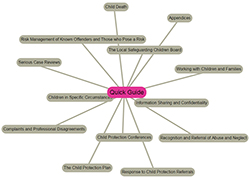7.4 The Child Protection Plan
The overall aims of the Child Protection Plan are:
- To ensure the child is safe and prevent him or her from suffering further harm by supporting the strengths, addressing the vulnerabilities and risk factors and helping meet the child's unmet needs;
- To promote the child's welfare, health and development; and
- Provided it is in the best interests of the child, to support the family and wider family members to safeguard and promote the welfare of their child.
The Child Protection Plan should set out what work needs to be done, why, when and by whom. The Plan should:
- State when and in what situations the child will be seen by the child's Lead Social Worker, both alone and with other family members or caregivers present;
- Describe the identified developmental needs of the child, and what therapeutic services are required;
- Include specific, achievable, child-focused outcomes intended to safeguard and promote the welfare of the child;
- Include realistic strategies and specific actions to achieve the planned outcomes;
- Include a Contingency Plan to be followed if circumstances change significantly and require prompt action;
- Clearly identify roles and responsibilities of professionals and family members, including the nature and frequency of contact by professionals with children and family members;
- Lay down points at which progress will be reviewed, and the means by which progress will be judged; and
- Set out clearly the roles and responsibilities of those professionals with routine contact with the child - e.g. health visitors, GP's and teachers - as well as those professionals providing specialist or targeted support to the child and family.
Whilst the welfare of the child must be the primary concern, the Child Protection Plan should take into account the wishes and feelings of the child and the views of the parents, and provide explanation where these wishes, feelings and views are not acted on.
The child (depending on his or her age and understanding) and the parents should be clear about the evidence of Significant Harm, which resulted in the child becoming the subject of a Child Protection Plan, what needs to change and what is expected of them as part of the plan for safeguarding and promoting the child's welfare. This should be the subject of continuing discussion with the Lead Social Worker and other professionals involved.
The Lead Social Worker should ensure that those with Parental Responsibility and any other relevant family members are provided with a copy of the Child Protection Plan in their first language and ensure that they understand the plan. The Lead Social Worker should also determine whether the family are willing to co-operate with the plan and encourage them to do so.
Where parents' co-operation or agreement is not forthcoming, the Lead Social Worker or supervisor should seek legal advice.

